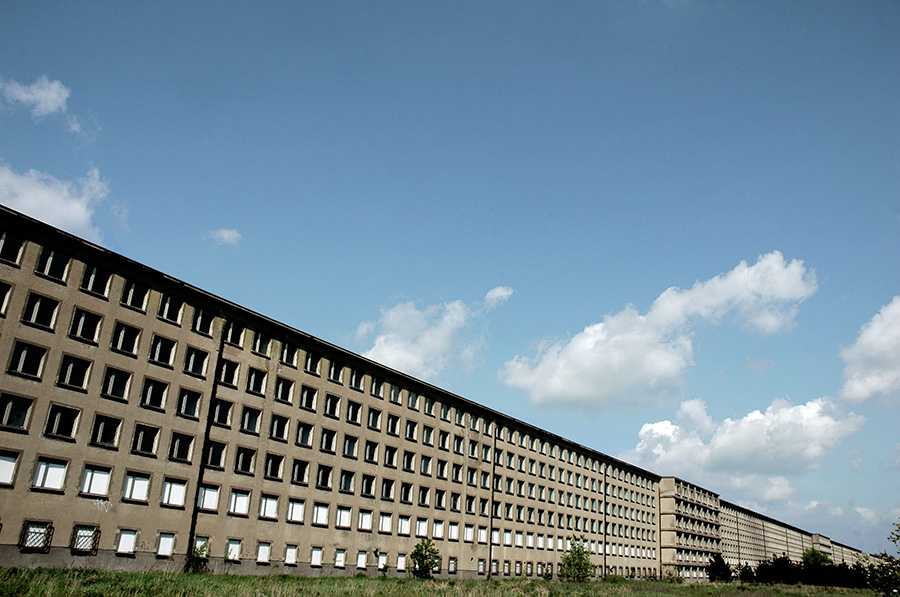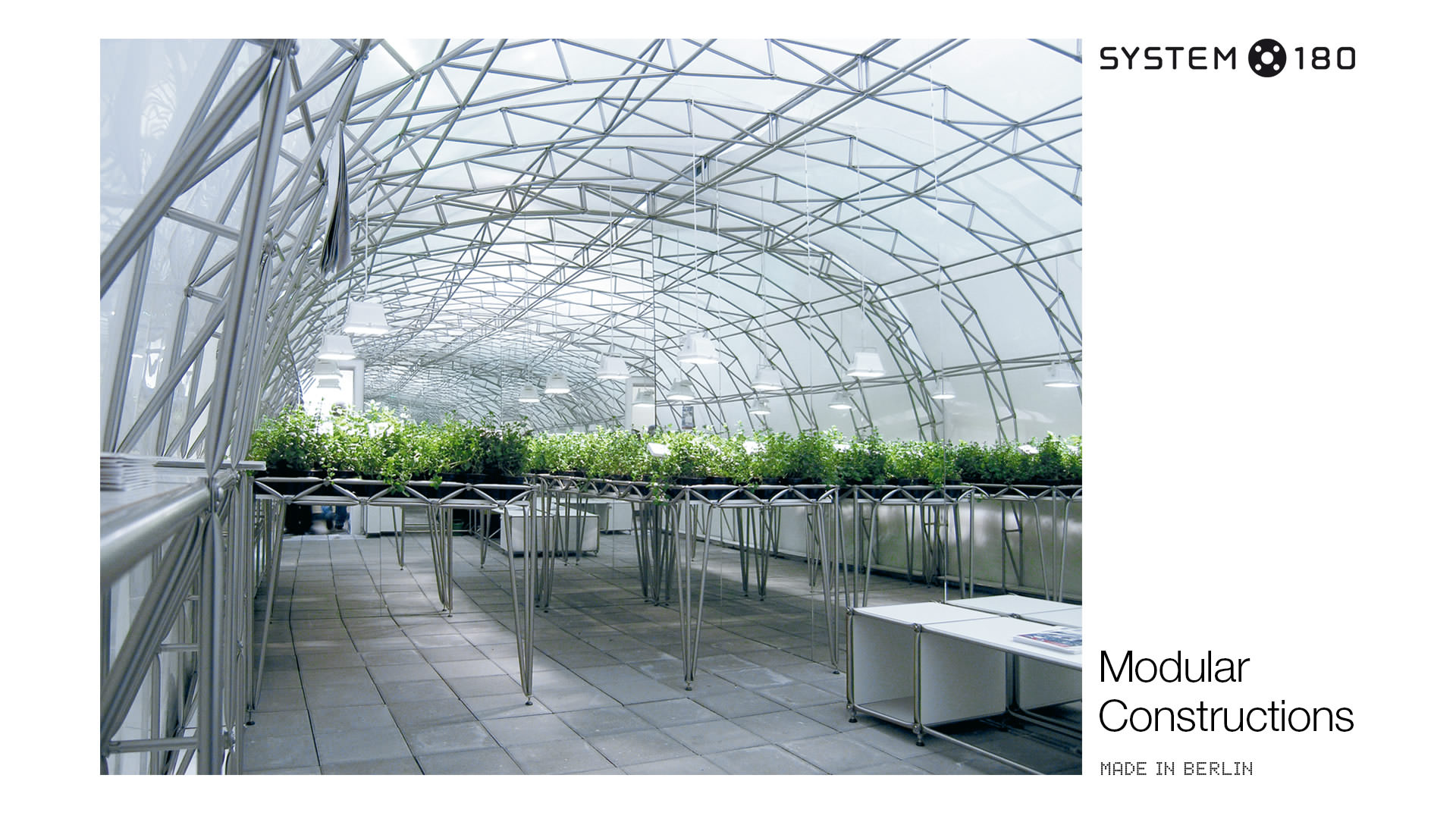-
Prora, the gigantic Nazi-built resort on the Baltic Sea
Text by Jessica Bridger
THE
COLOSSUS
OF RÜGEN
-

Prora stretches 4.5 kilometres along the Baltic Sea, a crumbling remnant of Nazi-era architecture and decades of indecision and neglect. (Photo: Martjin van Exel)
Nobody loves Prora. This massive holiday venue built by the Nazis, sprawling 4.5 kilometers along the Baltic Sea, has been as hard to re-purpose as it has been to snuff out right wing German nationalism. The complex could be almost anything to anyone, but somehow Prora is largely nothing to no one.
The uneasy history of the Prora complex clouds the past, present and future of this intended resort. Prora is located in the municipality of Binz on the island of Rügen, just off the coast of northern Germany. Composed of eight interconnected structures, it is sometimes referred to as The Colossus of Rügen. Its design was largely the work of architect Clemens Klotz, and it received a Grand Prix at the 1937 World Exhibition in Paris. The aesthetic and scale, along with the idealistic goals were the brainchild of Nazi Germany’s peculiar democratic aims.

The gigantic complex has been occupied by a motley crew of users. A sample interior of a room as fitted out during useage by the East German Government shows a rather modest set up for holiday goers.(Photo: Thorsten Schramm)
-
The Portuguese artist and filmmaker Nuno Cera has been preoccupied with addressing urban conditions with his films and photography since he graduated from the Maumaus School of Art and Photography in Lisbon in 1997. His 2003 work Cimêncio with the architect Diogo Lopes, for example, is about the suburban landscape and condition, and Futureland (2008-2010) is a huge artistic investigation of nine megacities across the world. His 2005 film Prora is one in which this decaying, historically-loaded building takes a starring role and conveys the melancholy vastness of the place.

Peeling paint in a corridor of Prora is merely one view of decay. This video by artist Nuno Cera portrays Prora in a poetic state of failing. (Photo and video: Nuno Cera)
-
Planned as a vacation venue for “the masses”, the project was managed by the National Socialist organization “Kraft durch Freude” (KdF/“Strength through Joy”). The scale of the project was supposed to accommodate 20,000 visitors at a time, providing year-round, comprehensive, two-week holiday packages for German citizens.
Today the hulking behemoth is largely in ruins. Its designation as a historically-important structure has saved it from a demolition that many might favour, given its problematic provenance and subsequent uses. Constructed between 1936-39, the complex was never entirely finished as the realities of World War Two intervened, and was therefore never used as intended. It functioned as a barracks, training ground and hospital for Nazi Germany and then later the Soviet armed forces and the German Democratic Republic’s Nationale Volksarmee (“National People’s Army”), who undertook military exercises with explosive munitions that partially destroyed some of the Prora complex’s buildings. Thereafter, the steady slide into decline continued apace: after all, what can really be done with a gigantic piece of architecture in a small town? Can a giant piece of architecture be "too big to fail"?

The seaside location of Prora has done little to draw interest over the years, though the nearby town of Binz draws well-heeled tourists to the Baltic: the potential is high, but reality proves instructive. (Photo: Flickr / loop_oh)
-
The Colossus of Prora currently houses a modestly-sized youth hostel with some 400 beds, a disco and two museums: one for the history of the building and one for motorcycles. The hostel is probably the closest the complex has come to the original idealistic vision of a vacation place for (a certain kind of) everyone. Investors have come and gone, economic conditions have fluctuated since German Reunification, and most of Prora still sits decaying. A revolving cast of figures have dreamt big about Prora’s potential to no avail. It somehow ends up dwarfing them all.
Together, the location, difficult history, sheer scale and a lack of cohesive vision have combined to keep Prora derelict and deteriorating. It suffers a fate similar to other large-scale Nazi era structures (when world domination is on the menu, thinking big tends to be de rigueur) such as Berlin’s former Tempelhof Airport. Tempelhof however has the benefit of being located directly in Germany's capital city, and though decisions about its reuse have been slow, temporary programs and ambitious development ideas prove that perhaps big architecture fares better in big cities, not small ones.

Today Prora draws museum and hostel visitors - and many who simply come to gawk at the ruins of a complex designed for occupancy by 20,000 people. (Photo: Flickr / Marc)
-
With all of Prora’s challenges under consideration, two real estate development concerns, Irisgerd and Prora Haus Wismar, are in the process of trying to pre-sell luxury condominiums in former sections of the Prora complex. As of October 2013 these projects are still largely at the “investment opportunity stage”, though renovations have begun to restore the façades in the sections that will become airy residences, priced at up to 700,000 Euros. From luxury condos to a youth hostel, there is no clear trajectory for the development of Prora, only section-by-section interpretations of a mixed future.

The Seesinfonie condos at Prora – and restored façade - in rendered splendor. (Images courtesy Prora Haus Wismar)

-
The fate of Prora still hangs in the balance, vacillating between museum, hostel, luxury dream, and ruin. Memory, democracy and money have all had ample room to operate within Prora, the Colossus of Rügen, although it seems that time favours decay. I
(Photo: Flickr / Marc)
-
Search
-
FIND PRODUCTS
PRODUCT GROUP
- Building Materials
- Building Panels
- Building technology
- Façade
- Fittings
- Heating, Cooling, Ventilation
- Interior
- Roof
- Sanitary facilities
MANUFACTURER
- 3A Composites
- Alape
- Armstrong
- Caparol
- Eternit
- FSB
- Gira
- Hagemeister
- JUNG
- Kaldewei
- Lamberts
- Leicht
- Solarlux
- Steininger Designers
- Stiebel Eltron
- Velux
- Warema
- Wilkhahn
-
Follow Us
Tumblr
New and existing Tumblr users can connect with uncube and share our visual diary.
»Intelligence starts with improvisation.«
Yona Friedman
Keyboard Shortcuts
- Supermenu
- Skip Articles
- Turn Pages
- Contents



